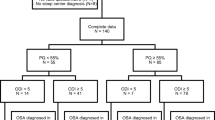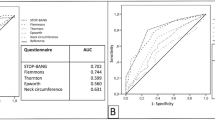Abstract
Purpose
Primary care is central for the diagnosis and treatment of obstructive sleep apnea (OSA). The aim of this study was to estimate the prevalence of symptoms and risk of OSA in primary care in Jordan.
Methods
A cross-sectional survey was conducted between July and October 2006. Adult patients attending primary health care in the north of Jordan were included and the Berlin questionnaire was utilized.
Results
A total of 1,205 patients completed the questionnaire, 46% were males, and mean age was 32.2 years. Based on the Berlin questionnaire definition, the overall OSA risk was 16.8%, snoring was present in 28.7% and frequent daytime fatigue or tiredness in 33.9%. OSA risk increased with age. For age groups <30 years, 30–59 years, and ≥60 years OSA risk was 5.4%, 28.4%, and 45.9%, respectively, (p < 0.005). OSA risk was higher in men than women (19.3% vs. 14.7%, respectively, p < 0.04). Age of ≥30 years, chronic nasal congestion and illiteracy were associated with an increased risk of OSA.
Conclusions
Obstructive sleep apnea, snoring, and daytime sleepiness were common among Jordanian patients attending primary care clinics. More attention to OSA is needed in primary care, and patients at risk should be referred for further evaluation.
Similar content being viewed by others
References
Young T, Palta M, Dempsey J et al (1993) The occurrence of sleep-disordered breathing among middle-aged adults. N Engl J Med 328:1230–1235 doi:10.1056/NEJM199304293281704
Young T, Peppard P, Gottlieb D (2002) Epidemiology of obstructive sleep apnea. A population health perspective. Am J Respir Crit Care Med 165:1217–1239 doi:10.1164/rccm.2109080
Durán J, Esnaola S, Rubio R et al (2001) Obstructive sleep apnea–hypopnea and related clinical features in a population-based sample of subjects aged 30 to 70 yr. Am J Respir Crit Care Med 163:685–689
Peker Y, Kraiczi H, Hedner J et al (1999) An independent association between obstructive sleep apnoea and coronary artery disease. Eur Respir J 14:179–184 doi:10.1034/j.1399-3003.1999.14a30.x
Yaggi HK, Concato J, Kernan WN et al (2005) Obstructive sleep apnea as a risk factor for stroke and death. N Engl J Med 353:2034–2041 doi:10.1056/NEJMoa043104
Goncalves MA, Paiva T, Ramos E et al (2004) Obstructive sleep apnea syndrome, sleepiness, and quality of life. Chest 125:2091–2096 doi:10.1378/chest.125.6.2091
Mazza S, Pépin JL, Naëgelé B et al (2005) Most obstructive sleep apnoea patients exhibit vigilance and attention deficits on an extended battery of tests. Eur Respir J 25:75–80 doi:10.1183/09031936.04.00011204
Adams N, Strauss M, Schluchter M et al (2001) Relation of measures of sleep disordered breathing to neuropsychological functioning. Am J Respir Crit Care Med 163:1626–1631
Terán-Santos J, Jiménez-Gómez A, Cordero-Guevara J (1999) The association between sleep apnea and the risk of traffic accidents. N Engl J Med 340:847–851 doi:10.1056/NEJM199903183401104
Findley L, Smith C, Hooper J et al (2000) Treatment with nasal CPAP decreases automobile accidents in patients with sleep apnea. Am J Respir Crit Care Med 161:857–859
Young T, Evans L, Finn L et al (1997) Estimation of the clinically diagnosed proportion of sleep apnea syndrome in middle aged men and women. Sleep 20:705–706
Dement WC, Netzer NC (2000) Primary care: is it the setting to address sleep disorders. Sleep Breath 4:1–6 doi:10.1055/s-2000-11529
Petrella RJ, Merikle EP, Jones J (2007) Prevalence, treatment, and control of hypertension in primary care: gaps, trends, and opportunities. J Clin Hypertens 9:28–35 doi:10.1111/j.1524-6175.2007.06580.x
Noel M, Hickner J, Ettenhofer T, Gauthier B (1998) The high prevalence of obesity in Michigan primary care practices. An UPRNet study. Upper Peninsula Research Network. J Fam Pract 47:39–43
Reuveni H, Tarasiuk A, Wainstock T et al (2004) Awareness level of obstructive sleep apnea syndrome during routine unstructured interviews of a standardized patient by primary care physicians. Sleep 27:1518–1525
Kushida CA, Nichols DA, Simon RD et al (2003) Symptom-based prevalence of sleep disorders in an adult primary care population. Sleep Breath 4:9–14 doi:10.1055/s-2000-11530
Netzer NC, Hoegel JJ, Loube D et al (2003) Prevalence of symptoms and risk of sleep apnea in primary care. Chest 124:1406–1414 doi:10.1378/chest.124.4.1406
Bahammam AS, Alrajeh MS, Al-Jahdali HH et al (2008) Prevalence of symptoms and risk of sleep apnea in middle-aged Saudi males in primary care. Saudi Med J 29:423–426
Netzer NC, Stoohs RA, Netzer CM et al (1999) Using the Berlin Questionnaire to identify patients at risk for the sleep apnea syndrome. Ann Intern Med 131:485–491
DOS (2006) Jordan In Figures 2006. In: The Hashemite Kingdom of Jordan Department of Statistics http://www.dos.gov.jo/jorfig/2006/jor_f_e.htm
Hiestand M, Britz P, Goldman M et al (2006) Prevalence of symptoms and risk of sleep apnea in the US population: results from the National Sleep Foundation Sleep in America 2005 Poll. Chest 130:780–786 doi:10.1378/chest.130.3.780
Ip MS, Lam B, Lauder IJ et al (2001) A community study of sleep-disordered breathing in middle-aged Chinese men in Hong Kong. Chest 119:62–69 doi:10.1378/chest.119.1.62
Ip MS, Lam B, Tang L et al (2004) Women in Hong Kong: prevalence and gender differences a community study of sleep-disordered breathing in middle-aged Chinese. Chest 125:127–134 doi:10.1378/chest.125.1.127
Steffens DC, Skoog I, Norton MC et al (2000) Prevalence of depression and its treatment in an elderly population: the Cache County study. Arch Gen Psychiatry 57:601–607 doi:10.1001/archpsyc.57.6.601
Evans JM, Hunder GG (2000) Polymyalgia rheumatica and giant cell arteritis. Rheum Dis Clin North Am 26:493–515 doi:10.1016/S0889-857X(05)70153-8
Conflict of Interest Statement
None of the authors have a conflict of interest to declare in relation to this work.
Author information
Authors and Affiliations
Corresponding author
Rights and permissions
About this article
Cite this article
Khassawneh, B., Ghazzawi, M., Khader, Y. et al. Symptoms and risk of obstructive sleep apnea in primary care patients in Jordan. Sleep Breath 13, 227–232 (2009). https://doi.org/10.1007/s11325-008-0240-4
Received:
Revised:
Accepted:
Published:
Issue Date:
DOI: https://doi.org/10.1007/s11325-008-0240-4




